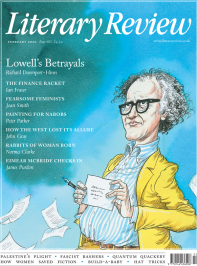Thomas Blaikie
Does She Wear One to Bed?
Hat: Origins, Language, Style
By Drake Stutesman
Reaktion Books 240pp £18
Hats are important. You only have to look at old photographs – say, of visitors to the Chelsea Flower Show in the 1930s: everybody in hats, men and women. Before the war, my grandmother spied Nancy Astor’s daughter in Bond Street without a hat. She agonised over whether to inform Lady Astor of this outrage. Yet when I encountered Drusilla Beyfus, great Vogue authority, in the green room before a radio show, she insisted that hats had never been a social obligation, merely a fashion. I don’t think hats were a fashion, though they were certainly subject to fashion.
You might assume that hat-wearing is now a thing of the past, but Drake Stutesman insists not. Look at the baseball cap or the beanie. But what is a hat and what is it for? One thing we can be sure of is that hats are not garments in the usual sense of the word. Only intermittently are they essential for warmth, keeping dry or cool. Quite often nowadays, hat wearers at weddings are keen to remove them as soon as possible. Hats are not comfortable. In most places today, they are not required for a person to meet society’s expectations of being dressed.
So is a hat merely decorative, an idle accessory? It would seem not, though women’s hats even today are almost always trimmed with ribbons, artificial flowers or feathers. We don’t think it odd that the Queen, champion and nearly lone hat wearer for the last fifty years, should appear at

Sign Up to our newsletter
Receive free articles, highlights from the archive, news, details of prizes, and much more.@Lit_Review
Follow Literary Review on Twitter
Twitter Feed
It wasn’t until 1825 that Pepys’s diary became available for the first time. How it was eventually decrypted and published is a story of subterfuge and duplicity.
Kate Loveman tells the tale.
Kate Loveman - Publishing Pepys
Kate Loveman: Publishing Pepys
literaryreview.co.uk
Arthur Christopher Benson was a pillar of the Edwardian establishment. He was supremely well connected. As his newly published diaries reveal, he was also riotously indiscreet.
Piers Brendon compares Benson’s journals to others from the 20th century.
Piers Brendon - Land of Dopes & Tories
Piers Brendon: Land of Dopes & Tories - The Benson Diaries: Selections from the Diary of Arthur Christopher Benson by Eamon Duffy & Ronald Hyam (edd)
literaryreview.co.uk
Of the siblings Gwen and Augustus John, it is Augustus who has commanded most attention from collectors and connoisseurs.
Was he really the finer artist, asks Tanya Harrod, or is it time Gwen emerged from her brother’s shadow?
Tanya Harrod - Cut from the Same Canvas
Tanya Harrod: Cut from the Same Canvas - Artists, Siblings, Visionaries: The Lives and Loves of Gwen and Augustus John by Judith Mackrell
literaryreview.co.uk